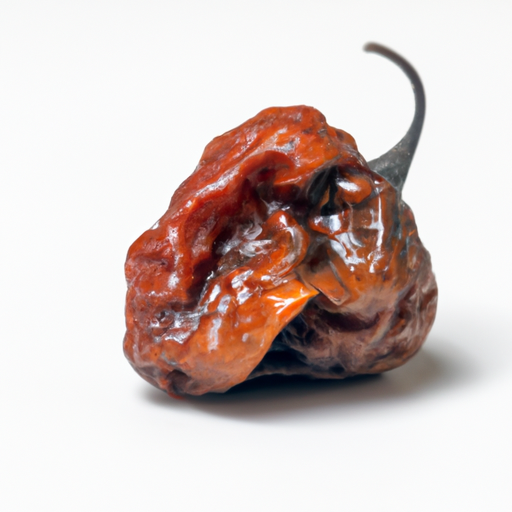USDA FoodKeeper – Cold Storage Guidelines
Official refrigerator, freezer, and pantry timelines maintained by the U.S. Department of Agriculture.
Visit USDA FoodKeeperWith its vibrant heat and complex flavor profile, this unique pepper variety can transform any dish into a culinary adventure. To enjoy its full potency, store it in a cool, dark place and remember that it has a short shelf life of just seven days—after that, it's best to toss it to avoid any potential risks.
Pepper C Chinense may remain safe to consume after its expiration date if it has been stored correctly at the proper temperature and shows no signs of spoilage. However, risk increases over time, especially if storage conditions were not optimal.


Cool Dark Place
50°F - 60°F (10°C - 15.5°C)
Store unwashed in a paper bag in a cool dark place.
7 days
Mold, soft spots, shriveled appearance
Used in stews, sauces, marinades, and traditional Yucatan and Caribbean-style cooking.
Can be substituted with other chili peppers like habanero or scotch bonnet.
Sure thing! So, expiration dates are more about safety, while best quality dates are more about taste. For Pepper C Chinense, the expiration date usually indicates when it's safe to eat, beyond that point, the quality and safety may decline. On the other hand, the best quality date suggests when the flavor and freshness might start to diminish, but it doesn't mean it's unsafe to consume. For instance, if the expiration date on your Pepper C Chinense is last week, it's probably best to toss it to be safe. But if the best quality date is a few days ago, it's still likely good to use, but the flavor might not be as vibrant. Personally, I tend to follow the expiration date for safety reasons but will often use products past their best quality date if they still look and smell okay. Trust your senses and use your best judgment when it comes to deciding whether to keep or toss your Pepper C Chinense!
To check if Pepper C Chinense has gone bad, look for any signs of mold, discoloration, or a slimy texture. If the pepper gives off a foul or sour smell, it is likely spoiled. Fresh Pepper C Chinense should have a firm and vibrant appearance with no signs of decay.
Hey there! Let's talk about Pepper C Chinense and how to stay safe while enjoying this spicy goodness. When it comes to foodborne illness risks, handling hot peppers like Pepper C Chinense requires some caution. One specific risk is cross-contamination. These peppers are hot stuff, literally, and can carry bacteria that might cause illness if not handled properly. Symptoms of foodborne illness can include stomach cramps, vomiting, and diarrhea. No fun at all! To stay safe, make sure to wash your hands thoroughly after handling these peppers. Avoid touching your face or eyes to prevent any accidental burns or irritation. It's also a good idea to wash your cutting board and knife right after using them to prevent any potential cross-contamination with other foods. I know how tempting it is to dive right into cooking with these fiery peppers, but taking a few extra precautions can make a big difference in keeping you and your loved ones safe and sound. So, enjoy your Pepper C Chinense, but do it with a side of caution!
Hey there! Storing Pepper C Chinense can be a breeze with a few handy tips. To keep them fresh longer, store them whole in a perforated plastic bag in the crisper drawer of your fridge. This helps maintain their moisture without making them soggy. If you want to preserve them for a more extended period, you can also freeze them. Simply chop them up, spread them out on a baking sheet to freeze individually, then transfer them to a freezer-safe bag. This way, you can grab a little bit whenever you need it without thawing the whole batch. For a fun twist, you can also pickle them to add a zesty kick to your dishes. I love making a quick pickling brine of vinegar, water, sugar, and salt to have them on hand for sandwiches and salads. Remember, the key is to keep them dry and away from direct sunlight to maintain their flavor and freshness. Give these storage hacks a try and see which one works best for you!
Hey there! Let's talk about the fascinating Pepper Chinense, also known as Habanero peppers. Did you know that these little fiery guys are believed to have originated in the Amazon region? They got their name from the Cuban city of La Habana, which is pretty cool if you ask me. Now, in terms of heat, these peppers are no joke. They pack a serious punch and are considered one of the hottest chili peppers in the world. So, if you have a low tolerance for spicy food, you might want to proceed with caution when handling or eating them. In terms of cultural significance, Habanero peppers are widely used in Caribbean, Mexican, and Central American cuisines. They add a delicious kick to dishes like salsas, hot sauces, and marinades. Plus, they are often featured in traditional dishes like jerk chicken and ceviche. So, next time you're looking to spice up your meal, consider adding some Pepper Chinense to the mix for a flavorful and fiery experience!
Pepper C Chinense should be stored in a cool, dark place. If it has been left at room temperature for an extended period, like a day or more, it's best to discard it. Bacteria can multiply rapidly at room temperature, increasing the risk of foodborne illness.
Once opened, Pepper C Chinense has a shelf life of about 3-4 days if stored properly in the refrigerator. Ensure it's tightly sealed in an airtight container to maintain freshness. Discard if there are any signs of spoilage, such as off odors or mold growth.
The type of container used to store Pepper C Chinense can impact its shelf life. Opt for airtight containers to prevent moisture loss, which can lead to wilting and spoilage. Glass or plastic containers with tight seals are good choices to maintain freshness.
Still not sure if it's safe?
Our Food Expiration & Storage Quick Guide helps you decide quickly — with clear keep-or-discard rules for the most common foods.
Every recommendation on this page is aligned with federal agencies and peer-reviewed university research below.
Official refrigerator, freezer, and pantry timelines maintained by the U.S. Department of Agriculture.
Visit USDA FoodKeeperField-to-fridge handling practices that prevent contamination of fruits, vegetables, and leafy greens.
Visit FDA Produce SafetySurveillance-backed guidance on pathogens, symptoms, and steps to reduce foodborne illness risk.
Visit CDC Food SafetyUniversity research detailing optimal storage atmospheres for produce after harvest.
Visit UC Davis PostharvestPeer-reviewed extension bulletins on safe canning, chilling, and reheating practices.
Visit Penn State ExtensionNeed deeper reading? Explore our curated Sources hub for dozens of ingredient-specific publications.
Reviewed by the Can I Eat Expired Editorial Team, using food safety guidance from the USDA, FDA, CDC, and university extension programs.
Beverages
View expiration date and storage guide →
Baking Supplies
View expiration date and storage guide →
Beverages
View expiration date and storage guide →
Health Supplements
View expiration date and storage guide →
Ethnic Foods
View expiration date and storage guide →
Fruits & Vegetables
View expiration date and storage guide →
Health Supplements
View expiration date and storage guide →
Health Supplements
View expiration date and storage guide →
Beverages
View expiration date and storage guide →
Important: These are general guidelines based on authoritative sources listed above. Always use your best judgment and when in doubt, throw it out. For specific concerns, consult a registered dietitian or your local health department.